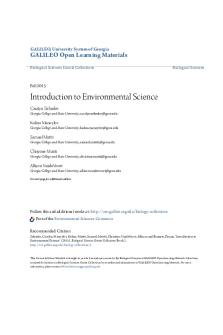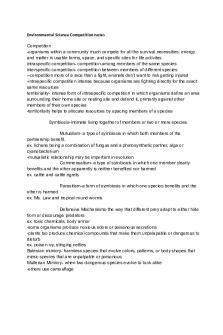Environmental Science and Engineering PDF

| Title | Environmental Science and Engineering |
|---|---|
| Author | Birla Reddy |
| Course | Mechanical engineer |
| Institution | Rajiv Gandhi University |
| Pages | 109 |
| File Size | 2.1 MB |
| File Type | |
| Total Downloads | 77 |
| Total Views | 167 |
Summary
Download Environmental Science and Engineering PDF
Description
Smartzworld.com
Smartwor
UNIT – I ENVIRONMENT, ECOSYSTEM AND BIODIVERSITY DEFINITION, SCOPE AND IMPORTANCE
CHAPTER 1 ENVIRONMENT, SCOPE AND IMPORTANCE
1.1 Introduction: Environmental science is the study of nature and the facts about environment. Basic environment can be defined as “all the social, economical, physical & chemical factors that surrou man” (or) “all abiotic and biotic components around man-all living and non-living things surrou man”. 1.2 Environment Components can be divided into biotic and abiotic components.
According to ancient man the environment was the Panchaboodhas (i.e) air, water, land, and energy. The human were disciples of nature. They were able to protect themselves from harm one and protect the others. But according to modern man the environment is only air land and wa Exploitation of various earth resources to satisfy the increasing needs of human population resulted in 1) depletion of various resources of earth 2) pollution. Principles of environmen education: Examine the major environmental issues Discover the root cause Develop problem solving skills Promote co-operation in solving problems Emphasis active participation in prevention and solution to problems. 1.3 Scope of environmental science: Studying the interrelationship between the components of env. Carrying out impact analysis and env. Audit Preventing pollution from existing and new industries Stopping the use of biological and nuclear weapons Managing unpredictable disasters etc. 1.4 Public awareness:
Environmental Pollution or problems cannot be solved by mere laws. Public participatio an important aspect which serves the environmental Protection. Public awareness of environmenta at infant stage 30-40% of public of developing country are aware of environmental. Problems they do not bother about it.
Ignorance and incomplete knowledge has lead to misconceptions
jntuworldupdates.org
Specw
Smartzworld.com
Smartwor
Development and improvement in std. of living has lead to serious environmental disasters Debate on environmental Issues are treated as anti-developmental 1.5 Reasons for environmental Ignorance:
Science, technology and economics failed to integrate the knowledge on environmen Aspects in curriculum the decision makers do not process environmental Angle of decision mak consideration of economic growth, poverty eradication has lead to environmental Degradation o few developmental activities are made considering the environmental Aspects. 1.6 Need For Public Awareness:
The United Nations Conference on Environment and Development held at Reo de Janeiro 1992 (popularly known as “Earth Summit”) and world summit on sustainable developmen Johannesburg in 2002, have highlighted the key issues of global environmental concern. They h attracted the attention of people. Any government at its own cannot achieve the goals of cl environment until the public participate in action. Public participation is possible only when public is aware about the ecological and environmental issues. Eg. Ban- the littering of polythene. 1.7 Methods to propagate environmental Awareness: 1. Among students through education – introducing environmental studies in the curriculum. 2. Among public through mass media- environmental programmmes through TV, radio etc. 3. Among decision makers, planners, leaders etc. 1.8 Role of NGOs
1. Advise the government in interacting with ground level people 2. Organize public meetings to create environmental awareness Eg. Recent report of “centre for science and environment on permissible limits of pesticides in cola drinks. Public awareness is needed in the area 3. Study of natural resources-conservation and management 4. Ecology and biodiversity – conservation 3. environmental Pollution and prevention 5. Social issues related to development and environment 6. Human population and environment.
jntuworldupdates.org
Specw
Smartzworld.com
Smartwor
CHAPTER 2
ECOSYSTEMS AND BIODIVERSITY
2.1 Ecosystem -living things in a given area, non-living chemical and physical factors of their environment, linked together through nutrient cycle and energy flow Types of Ecosystem
Artificial/Man-made
Natural Terrestrial
Aquatic Marine
Fresh water
Lotic -river, stream or spring.
Lentic -lake, pond or swamp.
2.2.1 Ecology - Study of the distribution and abundance of organisms, the flows of energy and materials between abiotic and biotic components of ecosystems.
2.2 Ecosystem Structure: The living components of an ecosystem • The roles of organisms in an ecosystem: • Producer (autotrophy): make food; plants, algae • Consumer (heterotrophy): eat other organisms • Decomposer: eat dead organic matter; bacteria and fungi
2.2.1 Classes of Consumers Herbivore – primary consumer – eats plants Carnivores – secondary – meat eaters; eat herbivores Tertiary – feed on carnivores Omnivores – eat plants/animals.
2.2.2 Role of Organisms Scavengers – feed on dead organisms (vultures, flies, crows, lobsters) Detritus feeders – organisms that extract nutrients from fragments of dead organisms into more simple organic waste (termites, earthworms, crabs)
Decomposers – organisms that digest parts of the dead organisms into simplest chemicals (bacteri fungi)
jntuworldupdates.org
Specw
Smartzworld.com
Smartwor
Fig. 2.2.2 Role of organisms
2.3 FOREST ECOSYSTEM (TERRESTRIAL ECOSYSTEM) 2.3.1 Introduction A forest is an area with a high density of trees. World’s total land area is 13,076 million hectares - (Source: FAO; 1989) Of which total forests account for about 31% of the world’s land area. In India, the forest cover is roughly 19% of the total land area. The forest ecosystems are of great concern from the environmental point of view. It provides numerous environmental services like; Nutrient cycling, Maintaining biodiversity Providing wildlife habitat Affecting rainfall patterns Regulating stream flow Storing water Reducing flooding Preventing soil erosion Reclaiming degraded land & many more…. Apart from environmental values, forest ecosystems have some traditional values as well. Examples are: Fire Wood & Timber. Fruits. Gums.
Herbs & drugs.
jntuworldupdates.org
Specw
Smartzworld.com
Smartwor
2.3.2 Structure and Function of Forest Ecosystem I. Biotic components The various biotic components, representatives from the three functional groups, of a forest ecosystem are: 1) Producer Organisms In a forest, the producers are mainly trees. Trees are of different kinds depending upon the type of forest developed in that climate. Apart from trees, climbers, epiphytes, shrubs and ground vegetation. Dominant species of trees in major types of forest ecosystems are: Tectona grandis, Acer, Betula, Picea, Pine, Cedrus. 2) Consumers In a forest, consumers are of three main types; a) Primary Consumers These are Herbivores which feed directly on producers. Eg: Ants, Beetles, Bugs, spiders etc. feeding on tree leaves.
Larger animals such as Elephants, Deer, giraffe etc. grazing on shoo and/or fruits of trees. b) Secondary Consumers These are carnivores and feed on primary consumers. Eg: Birds, Lizards, Frogs, Snakes and Foxes. c) Tertiary Consumers These are secondary carnivores and feed on secondary consumers These include top carnivores like Lion, Tiger. 3) Decomposers These include wide variety of saprotrophic micro- organism like; Bacteria (Bacillus Sp., Clostridium sp., pseudomonas. Fungi (Aspergillus sp., Ganoderma sp., Fusarium. Actinomycetes (Streptomyces). They attract the dead or decayed bodies of organisms & thus decomposition takes place. Therefore, nutrients are released for reuse. II. Abiotic components These include basic inorganic & organic compounds present in the soil & atmosphere. In addition dead organic debris is also found littered in forests.
jntuworldupdates.org
Specw
Smartzworld.com
Smartwor
Fig.2.3 Forest Ecosystem
2.4 GRASSLAND ECOSYSTEM (TERRESTRIAL ECOSYSTEM) 2.4.1 Introduction Grasslands (also called Greenswards) are areas where the vegetation is dominated by grasses and other herbaceous (non-woody) plants. Grasslands occupy about 24% of the earth’s surface. Grasslands occur in regions too dry for forests and too moist for deserts The annual rainfall ranges between 25- 75 cm, Usually seasonal The principal grasslands include: Prairies (Canada, USA),Pampas (South America),Steppes (Europe & Asia) Veldts (Africa)
The highest abundance & greatest diversity of large mammals are found in these ecosystem The dominant animal species include Wild horses, asses & antelope of Eurasia, Herds of Bison of America; and The antelope & other large herbivores of Africa. 2.4.2 Structure and functions of Grassland Ecosystems I. Biotic components
1) Producer Organisms
jntuworldupdates.org
Specw
Smartzworld.com
Smartwor
In grassland, producers are mainly grasses; though, a few herbs & shrubs also contribute to primary production of biomass. Some of the most common species of grasses are: Brachiaria sp., Cynodon sp., Desmodium sp., Digitaria sp. 2) Consumers In a grassland, consumers are of three main types; a) Primary Consumers The primary consumers are herbivores feeding directly on grasses. These are grazing anim such as Cows, Buffaloes, Sheep, Goats, Deer, Rabbits etc. Besides them, numerous species of insects, termites, etc are also present. b) Secondary Consumers These are carnivores that feed on primary consumers (Herbivores) These include;-Frogs, Snakes, Lizards, Birds, Foxes, Jackals etc. c) Tertiary Consumers These include hawks etc. which feed on secondary consumers. 3) Decomposers These include wide variety of saprotrophic micro- organism like: Bacteria; Fungi; Actinomycetes They attract the dead or decayed bodies of organisms & thus decomposition takes place. Therefore, nutrients are released for reuse by producers. II. Abiotic components
These include basic inorganic & organic compounds present in the soil & aerial environme The essential elements like C, H, N, O, P, S etc. are supplied by water, nitrogen, nitrates, sulphates, phosphates present in soil & atmosphere.
jntuworldupdates.org
Specw
Smartzworld.com
Smartwor
Fig.2.4 Grassland Ecosystem
2.5 DESERT ECOSYSTEM 2.5.1 Introduction A desert is a landscape or region that receives almost no precipitation.
Deserts are defined as areas with an average annual precipitation of less than 250 millimete per year. It occupies about 17% of the earth’s surface. Deserts are characterized by hot days & cold nights. The deserts of the world are mainly located in the South- western United States, Mexico, North America, Asia (Thar, Gobi, Tibet) & west Asia. Deserts are characterized by scanty flora & fauna. Soils of deserts often have abundant nutrients but little or no organic matter.
2.5.2 Sturucture and Functions of Desert Ecosystms I. Biotic components 1) Producer Organisms In a desert, producers are mainly shrubs/bushes; some grasses & a few trees.
Dominant plant species include: Succulents (water - retaining plants adapted to arid climat
or soil conditions) & hardy grasses.
jntuworldupdates.org
Specw
Smartzworld.com
Smartwor
Besides some lower plants such as lichens & xerophytic mosses are also present. 2) Consumer Organisms These include animals such as insects, reptiles which are capable of living in xeric conditions Besides some nocturnal rodents, birds & some mammalians like camel etc are also found. 3) Decomposers
Due to poor vegetation with very low amount of dead organic matter, decomposers are poor in desert ecosystem. The common decomposers are some bacteria & fungi, most of which are thermophillic. II. Abiotic components
Due to high temperature & very low rainfall, the organic substances are poorly present in the s
Fig. 2.5 Forest Ecosystem
2.6 AQUATIC ECOSYSTEMS 2.6.1 Introduction Aquatic ecosystems deal with biotic community present in water bodies. In terrestrial ecosystem, carbon dioxide & oxygen are present in gaseous form whereas in
aquatic ecosystem, these are available in dissolved state.
jntuworldupdates.org
Specw
Smartzworld.com
Smartwor
Depending upon the quality and nature of water, the aquatic ecosystem are categorized into Freshwater Ecosystem and Marine Ecosystem.
2.6.2 Freshwater Ecosystems Freshwater ecosystems cover 0.8% of the Earth's surface and contain 0.009% of its total water. Freshwater ecosystems contain 41% of the world's known fish species. Aquatic ecosystems perform many important environmental functions. For example: They recycle nutrients, purify water, attenuate floods, recharge ground water and provide habitats for wildlife. Aquatic ecosystems are also used for human recreation, and are very important to the tourism industry, especially in coastal region. There are three basic types of freshwater ecosystems: Lentic: slow-moving water, including Pools, Ponds, and Lakes. Lotic: rapidly-moving water, for example Streams and Rivers.
Wetlands: areas where the soil is saturated with water or inundated for at le part of the time
2.6.3 Lakes & pond Ecosystem A pond is a place where living organisms not only live but interact with biotic & abiotic components. Ponds are often exposed to tremendous anthropogenic pressure which significantly affects system. Lakes are usually big standing freshwater bodies.
They have a shallow water zone called Littoral zone; an open water zone where effective penetration of solar light takes place, called limnetic zone and a deep water zone where lig penetration is negligible, called Profoundal zone. I. Biotic components 1) Producer Organisms
It includes submerged, free floating and amphibious macrophytes (like; Hydrilla, Utricular Wolfia, Azolla, Typha etc.) and minute floating and suspended lower phytoplanktons (like Ulothrix, Spirogyra, Oedogonium etc.) 2) Consumer Organisms a) Primary consumers:These are zooplanktons (ciliates, flagellates, other protozoan, small crustaceans) and benthos. b) Secondary consumers: These are carnivores like insects and fishes feeding on herbivores c) Tertiary consumers: These are the large fishes feeding on small fishes. 3) Decomposers Micro – organisms like bacteria, fungi and actinomyctes.
II. Abiotic component
jntuworldupdates.org
Specw
Smartzworld.com
Smartwor
These are the inorganic as well as organic substances present in the bottom soil or dissolved in water. In addition, to the minerals, some dead organic matter is also present.
Fig.2.6.4 Zonation in a lake ecosystem
2.6.4 Marine or Ocean Ecosystem Marine ecosystems are among the Earth's aquatic ecosystems. They include: Oceans, Estuaries and Lagoons, Mangroves and Coral reefs, the Deep sea and the Sea floor. These are the gigantic reservoirs of water covering approximately 71% of the Earth's surface (an area of some 361 million square kilometers). These ecosystems are different from freshwater ecosystem mainly because of its salty wat The salt concentration in an open sea is usually 3.5% (35 parts per thousand (ppt)). Domin ions are sodium & chloride. Average temperature of Marine ecosystem is 2-3 degree centigrade, devoid of light. I. Biotic components
1) Producers It includes phytoplanktons (diatoms, dinoflagillates), large seaweeds (mainly algae l chlorophyceae, phaeophyceae & rhodophyceae; angiosperms like Ruppia, Zostera, posidonia ), an mangrove vegetation (like Rhizophora, Carapa etc.) 2) Consumers
a) Primary consumers: These are herbivores and feed directly on producers (Crustaceans, Mollusk fish etc.) b) Secondary consumers: These are carnivorous fishes (Herring, Sahd and Mackerel) c) Tertiary consumers: These are top carnivorous fishes (Cod, Haddock, etc.) 3) Decomposers These are micro – organisms like bacteria, fungi II. Abiotic components High Na, Ca, Mg and K salt concentration, variable dissolved oxygen content, light &
temperature make a unique physiochemical conditions in marine water.
jntuworldupdates.org
Specw
Smartzworld.com
Smartwor
Fig.2.6.5 Ocean Ecosystem
2.7 ENERGY FLOW IN ECOSYSTEM
All organisms must obtain a supply of energy and nutrients from their environment in orde survive.
The transformations of energy in an ecosystem begin first with the input of energy from the sun. Because, it is the first step in the production of energy for living things, it is called “Primar production”.
Photosynthesis -- Chemical reaction where green plants use water & carbon dioxide to stor the sun’s energy in glucose. ENERGY is stored in glucose. Glucose is stored as starch in plants
The majority of autotrophs are photoautotrophs that harness the energy of the sun and pass some of this energy onto consumers through feeding pathways. The energy contained within producers and consumers is ultimately passed to the decomposers that are responsible for the constant recycling of nutrients. Thus, there is a one-way flow of energy through the biotic community and a cycling of nutrients between the biotic and abiotic components of the ecosystem Energy flow cannot occur in reverse direction.
Starts from autotrophs (the producer level, i.e., first trophic level) to Heterotrophs includin plant eaters or Herbivores (second trophic level) and so on. The amount of energy decreases with successive trophic levels. Only About 1% of energy from the sun is used by green plants & rest remains unutilized. Similarly, there is loss of energy in each trophic level.
The transfer of food energy between the organisms in an ecosystem can be tracked by constructing food chains, food webs, pyramids of numbers, biomass and energy and energy
flow diagrams.
jntuworldupdates.org
Specw
Smartzworld.com
Smartwor
Fig.2.7 Energy Flow
2.8 FOOD CHAIN A food chain may be defined as, “the transfer of energy and nutrients through a series of organisms with repeated process of eating and being eaten”.
In an ecosystem, all the organisms are linked together with one another by food relationshi Each organism living or dead is potential food for some other organism.
jntuworldupdates.org
Specw
Smartzworld.com
Smartwor
Fig.2.8 Food Chain
2.9 FOOD WEB Under natural conditions, the linear arrangement of food chains hardly occurs & these remains connected interconnected with each other through different types of organisms. Interlocking pattern of several interlinked food chains is termed as FOOD WEB.
jntuworldupdates.org
Specw
Smartzworld.com
Smartwor
Fig.2.9 Food web in grassland ecosystem
2.10 ECOLOGICAL PYRAMIDS An”Ecological pyramid” is a graphical representation that shows the relative amounts of energy or matter contained within each tropic level in a food chain or foo...
Similar Free PDFs

Environmental Science and Engineering
- 109 Pages

Environmental Science
- 16 Pages

Environmental Science Module 1
- 4 Pages

Environmental Engineering-360607
- 123 Pages

Environmental Science Midterm Review
- 17 Pages

Environmental Science Questions
- 52 Pages

Environmental Science Review Sheet
- 19 Pages

Environmental Science Lecture notes
- 25 Pages

Environmental Science English Only
- 10 Pages
Popular Institutions
- Tinajero National High School - Annex
- Politeknik Caltex Riau
- Yokohama City University
- SGT University
- University of Al-Qadisiyah
- Divine Word College of Vigan
- Techniek College Rotterdam
- Universidade de Santiago
- Universiti Teknologi MARA Cawangan Johor Kampus Pasir Gudang
- Poltekkes Kemenkes Yogyakarta
- Baguio City National High School
- Colegio san marcos
- preparatoria uno
- Centro de Bachillerato Tecnológico Industrial y de Servicios No. 107
- Dalian Maritime University
- Quang Trung Secondary School
- Colegio Tecnológico en Informática
- Corporación Regional de Educación Superior
- Grupo CEDVA
- Dar Al Uloom University
- Centro de Estudios Preuniversitarios de la Universidad Nacional de Ingeniería
- 上智大学
- Aakash International School, Nuna Majara
- San Felipe Neri Catholic School
- Kang Chiao International School - New Taipei City
- Misamis Occidental National High School
- Institución Educativa Escuela Normal Juan Ladrilleros
- Kolehiyo ng Pantukan
- Batanes State College
- Instituto Continental
- Sekolah Menengah Kejuruan Kesehatan Kaltara (Tarakan)
- Colegio de La Inmaculada Concepcion - Cebu






